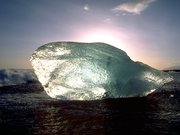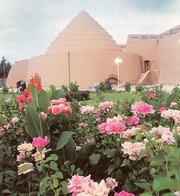Ice
|
|

Ice is the solid form of water. The phase transition occurs when liquid water is cooled below 0 °C (273.15 K, 32 °F) at standard atmospheric pressure. Ice can be formed at higher temperatures in pressurized environments, and water will remain a liquid or gas until -30 °C at lower pressures. Ice formed at high pressure has a different crystal structure and density than ordinary ice.
Ice, water, and water vapor can coexist at the triple point, which for this system is 273.16 K at a pressure of 611.73 Pa.
An unusual feature of ice frozen at a pressure of one atmosphere is that the solid is some 8% less dense than liquid water. Ice has a density of 0.917 g/cm³ at 0 °C, whereas water has a density of 0.9998 g/cm³ at the same temperature. Liquid water is most dense, essentially 1.00 g/cm³, at 4 °C and becomes less dense as the water molecules begin to form the hexagonal crystals of ice as the temperature drops to 0 °C. (In fact, the word "crystal" derives from the Greek word for frost.) This is due to hydrogen bonds forming between the water molecules, which line up molecules less efficiently (in terms of volume) when water is frozen. The result of this is that ice floats on liquid water, an important factor in Earth's climate.
As a crystalline solid, ice is considered a mineral.
| Contents |
Types of ice
SnowflakesWilsonBentley.jpg
Everyday ice and snow is ice Ih, or hexagonal ice. Subjected to higher pressures and varying temperatures, ice can form in roughly a dozen different phases. Only a little less stable (metastable) than Ih is cubic structure ice (Ic). But cooling Ih causes a different arrangement to form in which the protons move, XI.
With both cooling and pressure more types exist, each being created depending on the phase diagram of ice. These are II, III, V, VI, VII, VIII, IX, and X. With care all these types can be recovered at ambient pressure. The types are differentiated by their crystalline structure, ordering and density. There are also two metastable phases of ice under pressure, both fully hydrogen disordered, these are IV and XII. Ice XII was discovered in 1996. As well as crystalline forms solid water can exist in amorphous states as amorphous solid water (ASW), low density amorphous ice (LDA), high density amorphous ice (HDA), very high density amorphous ice (VHDA) and hyperquenched glassy water (HGW).
Note: In addition to these real variants of ice, a fictional "ice-nine" is featured in Kurt Vonnegut's novel Cat's Cradle. Real Ice IX does not have the properties of Vonnegut's fictional ice-nine (i.e. the ability to freeze all water on Earth with the introduction of one granule).
Rime is a type of ice formed by fog freezing on cold objects. It contains a high proportion of trapped air, making it appear white rather than transparent, and giving it a density about one quarter of that of pure ice.
Ice can also form icicles, similar to stalactites in appearance, as water drips and re-freezes.
Clathrate hydrates are forms of ice that contain gas molecules trapped within its crystal lattice. Pancake ice is a formation of ice generally created in areas with less calm conditions.
Some other substances (particularly solid forms of those usually found as fluids) are also called "ice": dry ice, for instance, is a popular term for solid carbon dioxide.
Ice is a common metaphor for things that are cold, hard, and clear in some way; for instance, "ice" is a colloquial term for diamond, and also for some forms of the drug amphetamine.
Human relationship with ice
Ice_pack.jpg
When ice melts, it absorbs as much heat energy (the heat of fusion) as it would take to heat an equivalent mass of water by 80 °C, while its temperature remains a constant 0 °C. Consequently, ice has long been valued as a means of cooling. Until recently, the Hungarian Parliament building used ice harvested in the winter from Lake Balaton as its primary source of energy for air conditioning. Icehouses were used to store ice during the winter so as to preserve perishables during the summer, and early refrigerators were known as iceboxes because they had a block of ice in them. The manufacture and use of ice cubes or crushed ice is common for drinks. Ice packs are commonly used to keep things cold while being transported.
In 400 BC Iran, Persian engineers had already mastered the technique of storing ice in the middle of summer in the desert. The ice was brought in during the winters from nearby mountains in bulk amounts, and stored in specially designed, naturally cooled refrigerators, called yakh-chal (meaning ice storage). This was a large underground space (up to 5000 m³) that had thick walls (at least 2 meters at the base) made out of a special mortar called sarooj, composed of sand, clay, egg whites, lime, goat hair, and ash in specific proportions, and which was resistant to heat transfer. This mixture was thought to be completely water impenetrable. The space often had access to a Qanat, and often contained a system of windcatchers that could easily bring temperatures inside the space down to frigid levels in summer days. The ice was then used to chill treats for royalty during hot summer days.
IcebreakerNasa.jpg
Ice can also be an obstacle; for harbors near the poles, being ice-free is an important advantage, ideally all-year round. Examples are Murmansk (Russia), Petsamo (Russia, formerly Finland) and Vardø. Harbors that are not ice-free are opened up using icebreakers.
Ice forming on roads is a dangerous winter hazard. Black ice is very difficult to see because it lacks the expected glossy surface. Whenever there is freezing rain or snow that occurs at a temperature near the melting point, it is common for ice to build up on the windows of vehicles, safely driving of which reauires removal of the ice. Ice scrapers are tools designed to break the ice free and clear the windows, though removing the ice can be a long, labor-intensive, and stressful process—especially when a driver ends up running late for work as a result.
Far enough below the freezing point, a thin layer of ice crystals can form on the inside surface of windows. This usually happens when a vehicle has been left alone after being driven for a while, but can happen while driving if the outside temperature is low enough. Moisture from the driver's breath is the source of water for the crystals. It is troublesome to remove this form of ice, so people often open their windows slightly when the vehicle is parked in order to let the moisture dissipate, and it is now common for cars to have rear-window defrosters to combat the problem. A similar problem can happen in homes, which is why many colder regions require double-pane windows to insulate the inner pane from the outer temperature (some homeowners even opt for triple-pane windows).
When the outdoor temperature stays below freezing for extended periods, very thick layers of ice can form on lakes and other bodies of water (although places with flowing water require much colder temperatures). The ice can become thick enough to drive onto in automobiles and trucks (even large semi-trailers). Doing this safely requires a thickness of at least 30 centimeters (one foot). The human quest for excitement has even led to ice racing, where drivers must go fast on lake ice while also controlling the skid of their vehicle (this is similar in some ways to dirt track racing). The sport has even been modified to work on ice rinks.
Tragically, it is a regular occurrence for people to fall through thin ice, and many die each year. Inventors and safety organizations continue to find new devices and methods to help rescue people from icy waters and the shock that a body undergoes in such situations.
See also
Icicles_forming.jpg
- diamond dust
- iceberg
- amorphous solid water (ASW)
- low density amorphous ice (LDA)
- high density amorphous ice (HDA)
- very high density amorphous ice (VHDA)
- hyperquenched glassy water (HGW)
- sea ice
- frazil ice
- pancake ice
- black ice
- water
- polynya
- deicing
- ice cream
- Europa, an ice-covered moon
- Firn
Related terms
- A rusticle is a rust formation similar to an icicle.
- Isaz is the Proto-Germanic rune for "ice".
- Ice is a slang term for methamphetamine.
External links
- The phase diagram of water, including the ice variants (http://www.its.caltech.edu/~atomic/snowcrystals/ice/ice.htm)
- Webmineral listing for Ice (http://www.webmineral.com/data/Ice.shtml)
- MinDat.org listing and location data for Ice (http://www.mindat.org/min-2001.html)
- The physics of ice (http://www-2.cs.cmu.edu/~dst/ATG/ice.html)
- The phase diagrams of water with some high pressure diagrams (http://www.martin.chaplin.btinternet.co.uk/phase.html)bg:Лед
ca:Gel cy:Iâ da:Is de:Eis et:Jää als:Eis es:Hielo eo:Glacio fr:Glace id:Es it:Ghiaccio he:קרח nl:IJs nds:Is ja:氷 no:Is pl:Lód pt:Gelo simple:Ice sl:Led su:És fi:Jää sv:Is zh:冰


